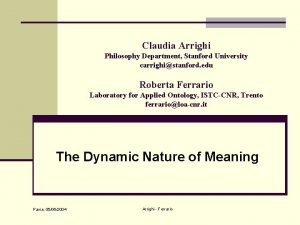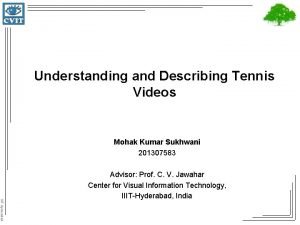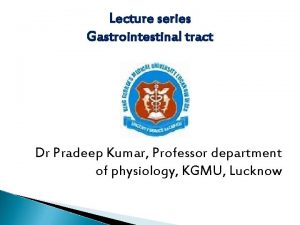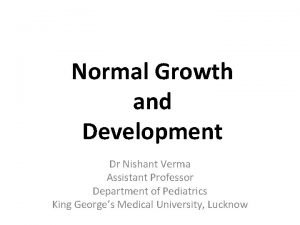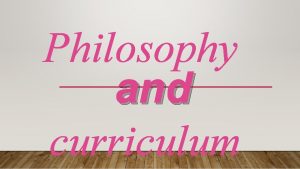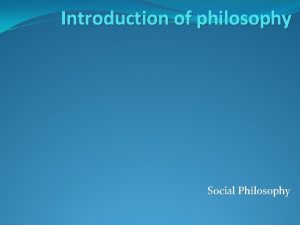Dr Tapan Kumar De Professor Department of Philosophy































- Slides: 31

Dr. Tapan Kumar De Professor Department of Philosophy Vidyasagar University 3/8/2021 tapande 4@gmail. com 1

• Gene therapy is an experimental technique that uses genes to treat or prevent disease. • Gene therapy is designed to introduce genetic material into cells to compensate for abnormal genes or to make a beneficial protein. If a mutated gene causes a necessary protein to be faulty or missing, gene therapy may be able to introduce a normal copy of the gene to restore the function of the protein. • Gene therapy is a form of therapy that involves inserting one or more corrective genes that have been designed in the laboratory, into the genetic material of a patient's cells to cure a genetic disease. 3/8/2021 tapande 4@gmail. com 2

• In the future, this technique may allow doctors to treat a disorder by inserting a gene into a patient’s cells instead of using drugs or surgery. • Researchers are testing several approaches to gene therapy, including: • Replacing a mutated gene that causes disease with a healthy copy of the gene. • Inactivating, or “knocking out, ” a mutated gene that is functioning improperly. • Introducing a new gene into the body to help fight a disease. 3/8/2021 tapande 4@gmail. com 3

• Some of the main diseases currently being researched in gene therapy studies include: • Cystic fibrosis • Sickle cell anemia • Hemophilia • Muscular dystrophy • Cancer 3/8/2021 tapande 4@gmail. com 4

• One of the main vectors used to carry modified genes into cells is the virus. Viruses usually attach to a host cell and transfer their viral genetic material into it. They then take over the cell and use the cell components to make copies of the virus. 3/8/2021 tapande 4@gmail. com 5

• Scientists can modify these viruses so that they contain only therapeutic and not viral genetic material but still retain their infective ability so that the beneficial DNA can be transferred into host cells. • Commonly used vectors include adenoviruses, adeno associated viruses, retroviruses and the herpes simplex virus. 3/8/2021 tapande 4@gmail. com 6

• There are two main types of gene therapy which include: • Somatic gene therapy • Germline gene therapy 3/8/2021 tapande 4@gmail. com 7

• With this form of therapy, only somatic cells (body cells) are targeted and not the germ line cells, otherwise known of as the gametes or sex cells. • If the modification of DNA is confined to body cells only, then the altered genome only effects the individual treated and not any offspring produced when the gametes join to form a zygote. 3/8/2021 tapande 4@gmail. com 8

• Transfer of a section of DNA to any cell of the body that doesn’t produce sperm or eggs. Effects of gene therapy will not be passed onto the patient’s children. 3/8/2021 tapande 4@gmail. com 9

• This involves incorporation of a tailored gene into the gametes, permanently altering the genes inherited by future generations. This type of therapy is prohibited in many countries due to ethical and technical concerns. • Transfer of a section of DNA to cells that produce eggs or sperm. • Effects of gene therapy will be passed onto the patient’s children and subsequent generations. 3/8/2021 tapande 4@gmail. com 10

• Because gene therapy involves making changes to the body’s set of basic instructions, it raises many unique ethical concerns. The ethical questions surrounding gene therapy include: • How can “good” and “bad” uses of gene therapy be distinguished? • Who decides which traits are normal and which constitute a disability or disorder? 3/8/2021 tapande 4@gmail. com 11

• Will the high costs of gene therapy make it available only to the wealthy? • Could the widespread use of gene therapy make society less accepting of people who are different? • Should people be allowed to use gene therapy to enhance basic human traits such as height, intelligence, or athletic ability? 3/8/2021 tapande 4@gmail. com 12

• Is it necessary to develop a new concept of therapy with unknown risks when there alternatives? • Is gene therapy ethically right or wrong? • How to deal with paediatric patients participating in clinical trials? • Is somatic gene therapy more or less ethical than germ-line gene therapy? • Do gene transfer clinical trials with genomic insertion always require a long-term follow-up? 3/8/2021 tapande 4@gmail. com 13

• There is a consensus that gene therapy should be therapy, i. e. the correction of bona fide disease conditions, rather than enhancement, which would mean "improving the human species" (whatever that means. . . ) and therefore would entail the introduction in human subjects of novel characteristics going beyond the usual, medical, understanding of health (i. e. health as absence of serious disease). 3/8/2021 tapande 4@gmail. com 14

• All current research on humans deals with somatic gene therapy. In these projects somatic cells such as bone marrow, liver, lung or vascular epithelium etc. are genetically modified. Since the germ line is not affected, all effects of therapy end with the life of the patient, at the very latest. In fact, most somatic therapies will probably require repeated applications, much like ordinary pharmacological treatments. 3/8/2021 tapande 4@gmail. com 15

• Initially, gene therapy was conceptualized mainly as a procedure to correct recessive monogenic defects by bringing a healthy copy of the deficient gene in the relevant cells. In fact, somatic gene therapy has a much broader potential if one thinks of it as a sophisticated means of bringing a therapeutic gene product to the right place in the body. The field has moved increasingly from a "gene correction" model to a "DNA as drug" model (ADN médicament, A. Kahn). • This evolution towards an understanding of gene therapy as "DNA based chemotherapy" underscores why the ethical considerations for somatic gene therapy are not basically different from the well known ethical principles that apply in trials of any new experimental therapy 3/8/2021 tapande 4@gmail. com 16

• In medical terms, it can be argued that to repair defective DNA so that the correct functioning of a gene is restored is a further extension of medicine, that has in the last 50 years taken us into hitherto unknown regions such as organ transplants, radiation therapy and in vitro fertilisation. 3/8/2021 tapande 4@gmail. com 17

• As our knowledge of the human body and its functioning has increased, we can now envisage treating patients at a genetic level. In this sense, it would seem to raise no ethical problems if, instead of injecting a vital protein that is deficient in a patient, the gene which should be stimulating the body to produce that protein might have its normal function restored. 3/8/2021 tapande 4@gmail. com 18

• Somatic gene therapy can be seen as a special case of medical treatment, in the sense of focussing familiar questions by the risks of a relatively unknown area of science, and the novel power and specificity of the level of intervention in the body. 3/8/2021 tapande 4@gmail. com 19

• In its report to the Government on the ethics of gene therapy, the Clothier Committe reported that although somatic gene therapy did not, in their view, represent a major departure from established medical practice, that familiar issues such as safety, unpredictable consequences and consent would assume greater importance because of the nature of genetic disorders. • With the new degree of power and specificity of treating the body at the genetic level comes also a new degree of sensititivity to error and uncertainty in a relatively young science. 3/8/2021 tapande 4@gmail. com 20

• There are some parallels in that sense with the development of nuclear physics from conventional physics, or lasers compared with ordinary light beams. Prudence indicates a proper caution, more than simply what would be required, say, for a new drug in extensive and careful trials, the due consideration of side effects, in long term monitoring, and in counselling and consent procedures. • Subject to such proper precautions, there would seem no more reason to object on ethical grounds to gene therapy than any existing therapy for a serious disease. On the contrary, as Christians we would strongly encourage efforts for the allieviation of the suffering of those with such diseases. 3/8/2021 tapande 4@gmail. com 21

• Of more concern is the generation of false optimism on the part of anyone involved scientists, medical staff, health authorities, Government, and especially any commercial biotechnology firms who market the drugs, diagnostics kits or other supplies. • It is important to resist the temptation to oversell one’s scientific discovery or therapy or product, to avoid creating unrealisitic expectations by the public in general, and especially vulnerable groups who might be anxious for any sort of remedy. • It seems likely that it will be many years before more than very modest claims could be made of gene therapy, but naturally we hope and pray that its promise may be fulfilled in significant improvements for sufferers from cycstic fibrosis and other diseases. 3/8/2021 tapande 4@gmail. com 22

• Because somatic gene therapy is directed at the body’s non reproductive cells, it should only affect the genetic makeup of that one individual, and not be passed on to any children they may subsequently have. • In contrast, any genetic changes in the reproductive cells – germ line gene therapy or changes made to the early embryo before the stage of differentiation into reproductive and non reproductive cells, would affect all future offspring of that person. • This makes an vital ethical distinction, affecting to major issues : 3/8/2021 tapande 4@gmail. com 23

• what is our duty in respect of future generations, their rights, choices, health, etc. ? could we ever know enough about the long term effects to judge that we could go ahead? The Present Technical and Legal Situation • If somatic therapy is in its infancy, germ line therapy is not even “a twinkle in the parent’s eye”. The technique is being used in higher animals in a number of applications, but in humans, it is not currently being seriously considered. Indeed, following the Clothier committee report, it is illegal in the UK to do research in this area. Nonetheless, in the US, the National Institutes of Health wishes to raise public discussion on the issue, and a patent application for germ line work on animals has included in its scope any potential human applications. 3/8/2021 tapande 4@gmail. com 24

• Cystic fibrosis (CF) is a genetic disorder that affects mostly the lungs, but also the pancreas , liver , kidneys, and intestine. • Long term issues include breathing difficulty and coughing up mucus as a result of frequent lung infections. • Other signs and symptoms may include sinus infections, poor growth, fatty stool, clubbing of the fingers and toes, and infertility in most males. • Different people may have different degrees of symptoms. 3/8/2021 tapande 4@gmail. com 25

3/8/2021 tapande 4@gmail. com 26

Sickle Cell Disease recessive allele • Red blood cells are sickle shaped, issues with circulation causing anemia and pain Based on: Harvard Family Health Guide, 1999

How is it done? Viral Vector Carrying Healthy Gene Cell with mutated gene(s) Vector inserts healthy gene into cell New gene in the cell along with original genes Functional proteins are created from therapeutic gene causing the cell to return to a normal state.

Hemophilia “Royalty Disease” • A disorder in which a person’s blood does not clot properly. • It is a recessive sex linked, X chromosome disorder. • 1 in 10, 000 males born are afflicted.

1. Gene silencing is a concept that in itself is self efficient for management of many dis eases. 2. Gene therapy has the potential to elimi nate and prevent hereditary diseases, such as cystic fibrosis, and is a possible cure for heart disease, AIDS and cancer. 3. Gives an advantage to a person born with genetic disorder to live life in a normal way by replacing non functional gene with a functional one. 30

1. Irregular immune responses. 2. Viral vectors may introduce toxicity, as well as immune and inflammatory re sponses. 3. Multi gene disorders such as heart disease, high blood pressure, Alzheimer’s disease, arthritis, and diabetes cannot be treated through this therapy as conditions or dis orders that arise only from mutations in a single gene are the best candidates for gene therapy. 4. Religious concerns. 5. Chances of inducing iatrogenic (physician induced) tumours in human beings. 6. Short lived nature of gene therapy. 3/8/2021 tapande 4@gmail. com 31
 Boron atom
Boron atom Porque tu crees que el tiempo cura y las paredes tapan
Porque tu crees que el tiempo cura y las paredes tapan Dr tapan patel wikipedia
Dr tapan patel wikipedia Promotion from assistant to associate professor
Promotion from assistant to associate professor Claudia arrighi
Claudia arrighi Col 106 amit kumar
Col 106 amit kumar Nmf immunisation
Nmf immunisation Alok kumar jagadev
Alok kumar jagadev Dr alok kumar pandey
Dr alok kumar pandey Amit kumar microsoft
Amit kumar microsoft Dr. pradip kumar khastagir
Dr. pradip kumar khastagir Nirupama prakash kumar
Nirupama prakash kumar Vijay kumar mit
Vijay kumar mit Rakesh kumar uiuc
Rakesh kumar uiuc Saturn
Saturn Chetan prakash vs met institute
Chetan prakash vs met institute Ibm cics training
Ibm cics training Mohak sukhwani
Mohak sukhwani Vikas kumar
Vikas kumar Dr anuj kumar tripathi neurosurgeon
Dr anuj kumar tripathi neurosurgeon Prof. dr. pradeep kumar gupta
Prof. dr. pradeep kumar gupta Col 106 amit kumar
Col 106 amit kumar Col 106
Col 106 Anil kumar nmr
Anil kumar nmr Kumar kom jet
Kumar kom jet Management assertions definition
Management assertions definition G ravindra kumar
G ravindra kumar Tan steinbach kumar
Tan steinbach kumar Vikas kumar
Vikas kumar Nishant verma md
Nishant verma md Chapter 9 kumar steinbach tan
Chapter 9 kumar steinbach tan Pavan kumar vijay
Pavan kumar vijay




